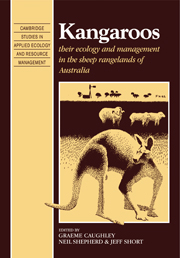Book contents
- Frontmatter
- Contents
- Preface
- Dedication
- THE STUDY AREA IN CONTEXT
- 1 Introduction to the sheep rangelands
- 2 The environment of the Australian sheep rangelands
- 3 The effect of weather on soil moisture and plant growth in the arid zone
- 4 Plant dynamics
- 5 The diet of herbivores in the sheep rangelands
- 6 Factors affecting food intake of rangelands herbivores
- 7 The mobility and habitat utilisation of kangaroos
- 8 Kangaroo dynamics
- 9 Condition and recruitment of kangaroos
- 10 Ecological relationships
- 11 Options for management of kangaroos
- Appendices to Chapter 8
- REFERENCES
- Author index
- Subject index
8 - Kangaroo dynamics
Published online by Cambridge University Press: 05 November 2011
- Frontmatter
- Contents
- Preface
- Dedication
- THE STUDY AREA IN CONTEXT
- 1 Introduction to the sheep rangelands
- 2 The environment of the Australian sheep rangelands
- 3 The effect of weather on soil moisture and plant growth in the arid zone
- 4 Plant dynamics
- 5 The diet of herbivores in the sheep rangelands
- 6 Factors affecting food intake of rangelands herbivores
- 7 The mobility and habitat utilisation of kangaroos
- 8 Kangaroo dynamics
- 9 Condition and recruitment of kangaroos
- 10 Ecological relationships
- 11 Options for management of kangaroos
- Appendices to Chapter 8
- REFERENCES
- Author index
- Subject index
Summary
Introduction
This chapter examines the relationship between the population dynamics of kangaroos and their food supply in an arid rangelands environment. The relationship is called the numerical response (Solomon, 1949) and was introduced to quantitative ecology by Holling (1959, 1961) to model one component of a predator-prey system. Trends in numbers of red and western grey kangaroos on Kinchega National Park and on surrounding properties were monitored every three months between 1973 and early 1984 by standardised aerial survey. Rates of increase of kangaroos were plotted as a function of rainfall and pasture biomass. Rainfall is the dominant influence on an arid zone grazing system (Noy-Meir, 1973) affecting the rate of increase of both the plants and the animals that eat them. However while rainfall is probably the ultimate factor determining rate of increase of kangaroos, the biomass of pasture available to the kangaroos as food is the proximate factor. Pasture biomass was measured on Kinchega and on an adjoining sheep station, Tandou, at three-monthly intervals coinciding with the aerial surveys between 1980 and early 1984 (Chapter 4).
There are few studies of the population dynamics of large mammalian herbivores, probably because most grazing systems are stable and so exhibit little dynamic behaviour. There are virtually no grazing studies that integrate the dynamic interaction of plants and animals, the exception being Sinclair's (1977) study on the African buffalo.
- Type
- Chapter
- Information
- KangaroosTheir Ecology and Management in the Sheep Rangelands of Australia, pp. 119 - 134Publisher: Cambridge University PressPrint publication year: 1987
- 34
- Cited by



